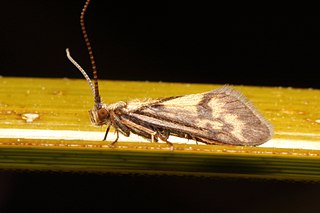
Conoesucidae is a family of caddisflies in the order Trichoptera. There are about 12 genera and more than 40 described species in Conoesucidae.

Drepanacra binocula, known as the Australian variable lacewing, is a species of brown lacewing in the family Hemerobiidae, found across Australia and New Zealand, including Lord Howe Island, Norfolk Island and the Kermadec Islands.

Protobiella zelandica is a species of New Zealand beaded lacewing in the family Berothidae that was first described by Robert John Tillyard in 1923. It is the sole known species in the genus Protobiella, and the only berothid endemic to New Zealand. No subspecies are noted in the Catalogue of Life.
Alloecentrella is a genus of caddisflies belonging to the order Trichoptera. The genus was first recognised by Keith Arthur John Wise in 1958.
Alloecentrella magnicornis is a species of caddisfly belonging to the order Trichoptera. The species was first described by Keith Arthur John Wise in 1958, and is endemic to New Zealand.

Ecnomina zealandica is a species of caddisfly belonging to the family Ecnomidae. The species was first described by Keith Arthur John Wise in 1958, and is endemic to New Zealand.

Neobiosella is a monotypic genus of caddisfly belonging to the family Philopotamidae. The sole species found in this genus is Neobiosella irrorata. Both the genus and species were first described by Keith Arthur John Wise in 1958. Neobiosella is endemic to New Zealand.

Oeconesus is a genus of caddisflies belonging to the family Oeconesidae. The genus was first recognised by Robert McLachlan in 1862. All known species of Oeconesus are endemic to New Zealand.

Pseudoeconesus bistirpis is a species of caddisfly belonging to the family Hydrobiosidae. The species was first described by Keith Arthur John Wise in 1958, and is endemic to New Zealand.

Olinga is a genus of caddisflies belonging to the family Oeconesidae. The genus was described by Robert McLachlan in 1868, revising the genus name in 1894. All known species of Olinga are endemic to New Zealand.

Olinga fumosa is a species of caddisfly belonging to the family Conoesucidae. The species was first described by Keith Arthur John Wise in 1958, and is endemic to New Zealand.

Pycnocentrodes aeris, also known as the common stony-cased caddisfly, is a species of caddisfly belonging to the family Conoesucidae. The species was first described by Keith Arthur John Wise in 1958, and is endemic to New Zealand.
Confluens is a genus of caddisflies belonging to the family Oeconesidae. The genus was described by Keith Arthur John Wise in 1962, after noticing differences in two species previously placed within the genus Pycnocentrodes. Both species of Confluens are endemic to New Zealand.
Polyplectropus impluvii is a species of caddisfly belonging to the family Polycentropodidae. The species was first described by Keith Arthur John Wise in 1962, and is endemic to New Zealand.
Orthopsyche thomasi is a species of caddisfly belonging to the family Hydropsychidae. The species was first described by Keith Arthur John Wise in 1962, and is endemic to New Zealand.
Orthopsyche is a genus of caddisflies belonging to the family Hydropsychidae. The genus was described by Alex G. McFarlane in 1976. Species of Orthopsyche can be found in New Zealand and New Caledonia.

Costachorema notopterum is a species of caddisfly belonging to the family Hydrobiosidae. The species was first described by Keith Arthur John Wise in 1972, and is endemic to the Auckland Islands of New Zealand.
Tiphobiosis kuscheli is a species of caddisfly belonging to the family Hydrobiosidae. The species was first described by Keith Arthur John Wise in 1972, and is endemic to the Auckland Islands of New Zealand.

Psilochorema embersoni is a species of caddisfly belonging to the family Hydrobiosidae. The species was first described by Keith Arthur John Wise in 1982, and is endemic to New Zealand.

Edpercivalia harrisoni is a species of caddisfly belonging to the family Hydrobiosidae. The species was first described by Keith Arthur John Wise in 1982, and is endemic to New Zealand.












